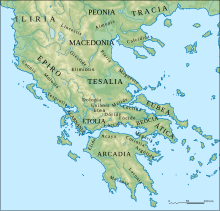Tymfaia
Tymfaia (bahasa Yunani Kuno: Τυμφαία, translit. Tymfaía) atau Stymfaia (bahasa Yunani: Στυμφαία, translit. Stymfaía) adalah suatu daerah Yunani Kuno terletak di Epiros, yang dihuni oleh suku Tymfaioi, suatu suku Yunani kuno di barat daya yang merupakan bagian dari koinon (wilayah kesukuan) Molossia.[1][2] Daerah suku itu dicaplok oleh dan menjadi bagian dari sebuah provinsi Kerajaan Makedon, bernama Makedonia Hulu, pada abad ke-4 SM.[3]

Sejarah
suntingKarena fakta bahwa toponimi Yunani yang melestarikan fitur kuno banyak ditemukan di wilayah yang lebih luas, diduga penutur bahasa Proto-Helenik bermukim di daerah yang termasuk Tymfaia sebelum migrasi Zaman Perunggu akhir (akhir milenium ke-3 hingga awal milenium ke-2 SM) selama beberapa abad atau bahkan ribuan tahun sebelumnya.[4] Tymfaia dan penduduk berbahasa Helenik, Tymfaioi, dinamai dari Gunung Tymfe.[5] Pada sekitar tahun 350 SM, Tymfaia ditaklukan oleh Filipos II (m. 359–336 SM) dan dicaplok ke dalam Kerajaan Makedon sebagai bagian dari Makedonia Hulu.[3][6] Penduduk asli Tymfaia yang paling terkenal adalah Poliperkones, seorang bupati di bawah kekuasaan Aleksander III (m. 336–323 SM). Dia adalah putra Simmias, yang merupakan penguasa Tymfaioi pada sekitar tahun 370 SM.[7]
Suku Tymfaioi merupakan bagian dari suku Molossia.[1] Mereka adalah salah satu suku Epiros dari kelompok penutur bahasa Yunani Barat Laut.[8] Mereka menyembah Zeus dengan nama "Deipaturos" mungkin sebagai dewa gunung mereka, Tymfe.[9]
Lihat pula
suntingReferensi
suntingCatatan kaki
sunting- ^ a b Hammond 1982, hlm. 276: "As we leave the coastal area, we may turn first to the middle and upper Haliacmon valley, where Elimeotis, Tymphaea and Orestis were inhabited by Epirotic tribes, or more correctly 'Molossian' tribes if the account in Strabo was derived from Hecataeus."
- ^ Hammond 1993, hlm. 132–133: "Further, the tribes which Strabo termed "Epirotic" — Orestai, Tymphaioi, Elimiotai, Lynkestai and Pelagones — are likely to have spoken the same dialect as the Molossians, to whom they were in some sense related."
- ^ a b Hammond 1994, hlm. 206: "When Philip annexed Elimea, Orestis, and Lyncus and territory up to Lake Lychnitis, reorganized the administration, and planted towns such as Heraclea Lyncestis, he was in a position to recruit and train infantry from these areas, ready for service perhaps by 352 B.C.; and similarly from Tymphaea, annexed probably in 350 B.C., infantry ready for service by 345 B.C."
- ^ Georgiev 1973, hlm. 247: "The region north of this line, which comprises Epirus as far as Aulon, in the north (including Paravaia, Tymphaea, Athamania, Dolopia, Amphilochia and Acarnania), western and northern Thessaly (Hestiaeotis, Perrhaebia, Tripolis) and Pieria, i.e. approximately the whole of northern and north-western Greece, is characterized by the following features. 1. Absence of pre-Hellenic place-names. [...] All the principal names north of the line are of archaic Greek origin. [...] Thus in the region defined just above, roughly northern and northwestern Greece. [...] Since Greek place-names are very dense in that region and they have a very archaic appearance, one may suppose that the proto-Greeks were settled in it during many centuries and even millennia."
- ^ Hammond 1993, [p. 141] "We see here the origins of the Tymphaioi (named after Mt. Tymphe) Orestai, Lynkestai and Pelagones, who practiced this way of life and were each a cluster of tribes."; [p. 143] "... the "Tymphaioi" were so named from the mountain Tymphe."
- ^ Hatzopoulos 1996, hlm. 249: "Finally, the fourth meris gathered the Upper Macedonian ethne (Lynkestai, Tymphaioi, Atintanes), to which Pelagonia (presumably with Derriopos), in other words the western part of the former strategia of Paionia, was added."
- ^ Pleket, Stroud & Strubbe 1994, p. 124: "Polyperchon, one of Alexander's generals and later regent (319 B.C.), son of Simmias who ruled the Tymphaioi ca. 370 B.C."
- ^ Hammond 1967, hlm. 538.
- ^ Hammond 2000, hlm. 6.
Daftar pustaka
sunting- Benveniste, Émile (2016) [1969]. Dictionary of Indo-European Concepts and Society (dalam bahasa Inggris). Chicago, IL: Hau Books (University of Chicago Press). ISBN 978-0-9861325-9-9.
- Georgiev, Vladimir I. (1973). "The Arrival of the Greeks in Greece: The Linguistic Evidence". Dalam Crossland, R. A.; Birchall, Ann. Bronze Age Migrations in the Aegean; Archaeological and Linguistic Problems in Greek Prehistory: Proceedings of the First International Colloquium on Aegean Prehistory, Sheffield. London: Gerald Duckworth & Company Limited. hlm. 243–253. ISBN 978-0-7156-0580-6.
- Hammond, Nicholas (2000). "The Ethne in Epirus and Upper Macedonia". The Annual of the British School at Athens. 95: 345–352. doi:10.1017/S0068245400004718. JSTOR 30103439.
- Hammond, Nicholas Geoffrey Lemprière (1994). Collected Studies. III. Amsterdam: Hakkert.
- Hammond, Nicholas Geoffrey Lemprière (1967). Epirus: The Geography, the Ancient Remains, the History and the Topography of Epirus and Adjacent Areas. Oxford: The Clarendon Press.
- Hammond, Nicholas Geoffrey Lemprière (1993). Studies Concerning Epirus and Macedonia Before Alexander. Amsterdam: Hakkert. ISBN 9789025610500.
- Hammond, Nicholas Geoffrey Lemprière (1982). "CHAPTER 40 ILLYRIS, EPIRUS AND MACEDONIA". Dalam Boardman, John; Hammond, Nicholas Geoffrey Lemprière. The Cambridge Ancient History: The Expansion of the Greek World, Eighth to Sixth Centuries B.C. III, Part 3 (edisi ke-2nd). Cambridge: Cambridge University Press. hlm. 261–285. ISBN 0-521-23447-6.
- Hatzopoulos, Miltiades V. (1996). Macedonian Institutions Under the Kings: A Historical and Epigraphic Study, Volume 1. Athens: Kentron Hellēnikēs kai Rōmaïkēs Archaiotētos. ISBN 978-960-7094-90-2.
- Pleket, H. W.; Stroud, R. S.; Strubbe, Johan (1994). Supplementum Epigraphicum Graecum, Volumes 44–45. Amsterdam: J.C. Gieben. ISBN 9789050635288.
Pustaka lanjutan
sunting- Hazlitt, William (1851). "Tymphaea". The Classical Gazetter. hlm. 360. Diarsipkan dari versi asli tanggal 2012-10-11.